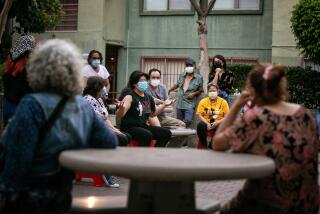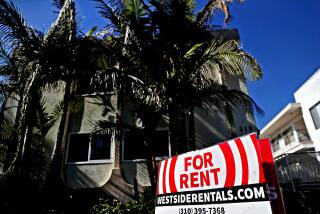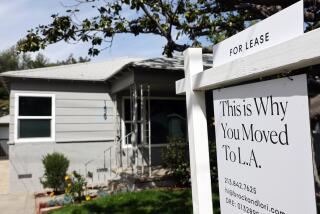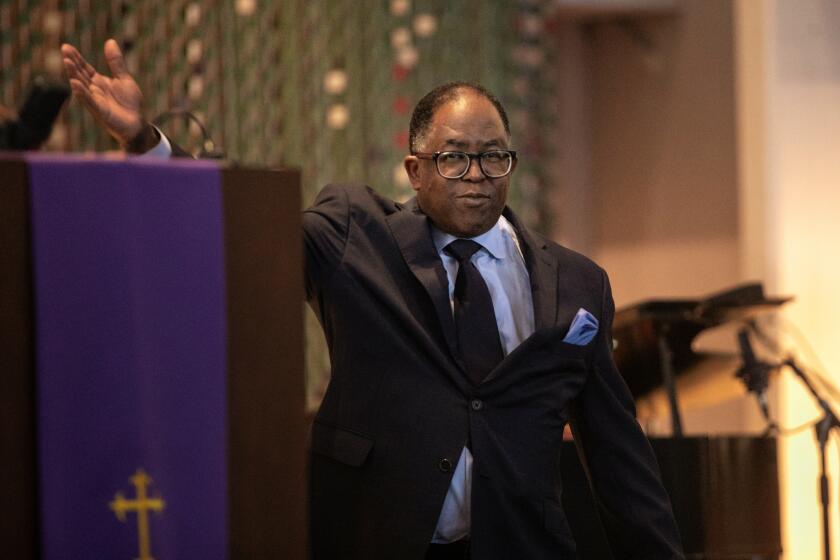Column: Landlords need to stop whining about the unfairness of California’s eviction ban
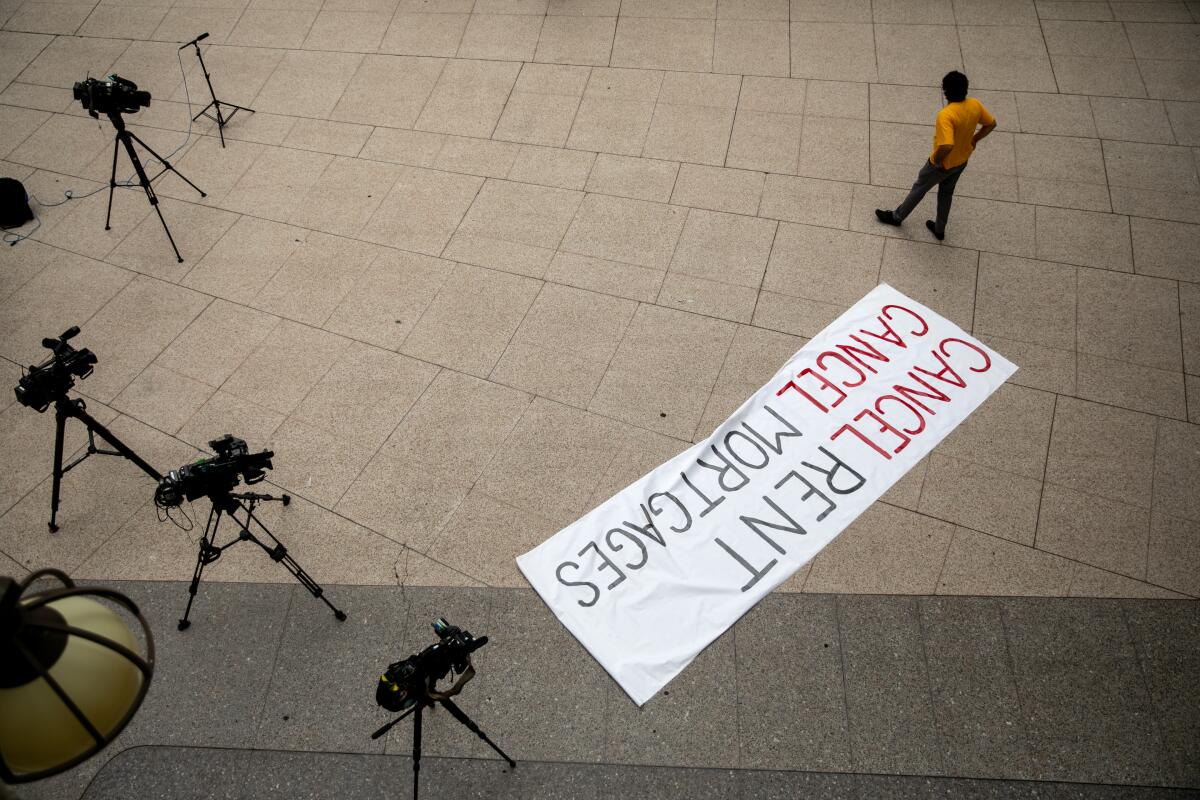
Gov. Gavin Newsom likes to talk about California “meeting the moment.” Well, for millions of renters, there’s perhaps no moment more worth meeting than Sept. 1.
That’s the day — a mere eight days from now — when a statewide moratorium on evictions is set to expire and families across the state, including many with children, could suddenly find themselves being booted from their homes into the street. At least one study has predicted that as many as 5.4 million households could go off the so-called eviction cliff.
The only thing that can save them now is a last-minute legislative compromise from state lawmakers, guided by the governor’s office. But when asked about the chances of doing so in time to, you know, meet the moment, Newsom has often veered from vague to flippant to defensive.
It’s a reflection of the worrisome political reality that, even now, with disastrous consequences drawing ever nearer for a state that already leads the nation in homelessness, his office and state lawmakers are trying to figure out a way to make landlords happy.
“Every day, I’m asked this question and every day I make the same point, and forgive me for all of you having to make it again,” Newsom said in a clipped tone on Friday, flanked by emergency personnel gathered to discuss the wildfires burning homes and forests across Northern California.
“As I’ve said, we’ve had very good conversations and made tremendous progress. The progress includes considerations of large landlords, large apartment owners, small apartment owners, advocates for tenants and the like.”
“We are committed to getting it done,” he added tersely. “It is one of our top priorities. Everybody recognizes we need to deliver and I’m confident we will.”
To be sure, the cost of failure would be unacceptably high for a state that, in addition to the number of people living in encampments under bridges and alleys, leads the nation in poverty when the cost of living is factored in. Those most at risk for eviction come Sept. 1 were living paycheck to paycheck before the COVID-19 pandemic and now have lost their jobs because of it.
And yet, the powerful and well-funded California Apartment Assn. and California Chamber of Commerce have come out against the last anti-eviction bill standing. AB 1436 from Assemblyman David Chiu (D-San Francisco) would prohibit the removal of renters who miss payments for either until 90 days after the COVID-19 state of emergency ends or April 2021, whichever occurs first.
The bill also would provide a year of mortgage relief, allowing a pause or reduction in payments to some property owners and landlords. But they are understandably skeptical about that promise of forbearance because of concerns about whether out-of-state banks would actually honor it. Instead, they would prefer to prevent evictions by receiving tax credits in place of rent — a proposal that was in another bill that state lawmakers sidelined earlier this month.
Under AB 1436, warned Debra Carlton, the apartment association’s executive vice president, landlords “will lose their rental units and tenants will eventually lose their homes.”
It’s a sentiment echoed by dozens of landlords and property managers who flooded my inbox after I wrote about what the coming “eviction cliff” — as many have dubbed it — would do to the most vulnerable California residents.
“Why are we expected to bear nearly the entire financial burden of families who are out of work?” one wanted to know. Another, citing the need to pay property taxes and utilities and to make repairs, demanded: “Who is supposed to pay these expenses?”
Many griped about how tenants will abuse an extended eviction ban, using it as an excuse to skip rent even when they have the money to pay. Others pointed out that as mom-and-pop landlords, they use the rent they get from their tenants to pay their own mortgage and, without a reprieve, could soon end up homeless themselves.
I get it. The fear of foreclosure is real, as is the painful possibility that corporate investors will come in to snap up their properties. There is no doubt that what has been happening to many landlords over the last few months has been deeply unfair.
But what has been happening to many tenants has been deeply unfair for a lot longer than that.
Consider that between 2010 and 2019, for example, the average rent in the city of Los Angeles climbed 65% to $2,527. During the same period, the median household income grew 36% to $64,036. There’s a reason about 150 people become homeless in L.A. County every day and only about 130 homeless people get into housing — and sky-high rental prices have a lot to do with it.
Statewide, the story is much the same. Today, according to Zillow, the median rent in California is $2,775, with many people using more than a third of their income to pay for it. And though there have been signs that rental prices have been falling lately, most of the declines seem to be for the most expensive apartments, while rents in more affordable neighborhoods, at least in L.A., are essentially flat, as my Times colleague Andrew Khouri reported.
It’s also worth noting that, according to the National Multifamily Housing Council, some 93% of tenants have been paying at least part of their rent every month during the pandemic. That’s a percentage, I imagine, that will decline as unemployment checks shrink.
Meanwhile, the numbers show that Californians who bought homes and investment properties after the Great Recession, have seen mostly gains since then. The median home price has jumped from $251,000 in 2012 to $533,500 in 2020.
Study after study shows that property owners, in general, and landlords, in particular, tend to be better off financially than those who rent. And it’s renters pulling in the most meager incomes who have found themselves most vulnerable to COVID-19 and the economic upheaval it has wrought.
For sure, there are exceptions. All renters aren’t on the verge of financial ruin and all landlords aren’t sitting pretty. But landlords have indeed benefited from a system that, though not of their creation, has long been tilted in their favor with beneficial tax policies and a housing shortage that has allowed rents to rise mostly unchecked.
It could be that this is what a pandemic-induced market correction looks like.
The fundamental problem is that by giving too much weight to the demands of landlords, California would be enabling what could only be construed as a return to the status quo, in which renters — many of them Black and Latino — continue to pay exorbitant sums to keep a roof over their heads. As if the status quo was ever acceptable.
I do hope that Newsom and lawmakers can hammer out a compromise before the state goes off the eviction cliff. But if they must choose, there’s only one acceptable choice. This time, it must be renters.
More to Read
Sign up for Essential California
The most important California stories and recommendations in your inbox every morning.
You may occasionally receive promotional content from the Los Angeles Times.
